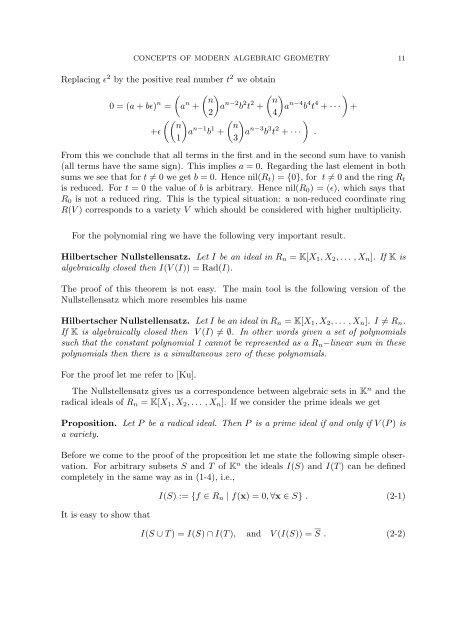Mannheimer Manuskripte 177 gk-mp-9403/3 SOME CONCEPTS OF ...
Mannheimer Manuskripte 177 gk-mp-9403/3 SOME CONCEPTS OF ...
Mannheimer Manuskripte 177 gk-mp-9403/3 SOME CONCEPTS OF ...
- No tags were found...
Create successful ePaper yourself
Turn your PDF publications into a flip-book with our unique Google optimized e-Paper software.
<strong>CONCEPTS</strong> <strong>OF</strong> MODERN ALGEBRAIC GEOMETRY 11Replacing ǫ 2 by the positive real number t 2 we obtain( ( ( )n n0 = (a + bǫ) n = a n + a2)n−2 b 2 t 2 + a4)n−4 b 4 t 4 + · · · +(( ( )n n+ǫ a1)n−1 b 1 + a3)n−3 b 3 t 2 + · · · .From this we conclude that all terms in the first and in the second sum have to vanish(all terms have the same sign). This i<strong>mp</strong>lies a = 0. Regarding the last element in bothsums we see that for t ≠ 0 we get b = 0. Hence nil(R t ) = {0}, for t ≠ 0 and the ring R tis reduced. For t = 0 the value of b is arbitrary. Hence nil(R 0 ) = (ǫ), which says thatR 0 is not a reduced ring. This is the typical situation: a non-reduced coordinate ringR(V ) corresponds to a variety V which should be considered with higher multiplicity.For the polynomial ring we have the following very i<strong>mp</strong>ortant result.Hilbertscher Nullstellensatz. Let I be an ideal in R n = K[X 1 ,X 2 ,... ,X n ]. If K isalgebraically closed then I(V (I)) = Rad(I).The proof of this theorem is not easy. The main tool is the following version of theNullstellensatz which more resembles his nameHilbertscher Nullstellensatz. Let I be an ideal in R n = K[X 1 ,X 2 ,... ,X n ]. I ≠ R n .If K is algebraically closed then V (I) ≠ ∅. In other words given a set of polynomialssuch that the constant polynomial 1 cannot be represented as a R n −linear sum in thesepolynomials then there is a simultaneous zero of these polynomials.For the proof let me refer to [Ku].The Nullstellensatz gives us a correspondence between algebraic sets in K n and theradical ideals of R n = K[X 1 ,X 2 ,... ,X n ]. If we consider the prime ideals we getProposition. Let P be a radical ideal. Then P is a prime ideal if and only if V (P) isa variety.Before we come to the proof of the proposition let me state the following si<strong>mp</strong>le observation.For arbitrary subsets S and T of K n the ideals I(S) and I(T) can be definedco<strong>mp</strong>letely in the same way as in (1-4), i.e.,It is easy to show thatI(S) := {f ∈ R n | f(x) = 0, ∀x ∈ S} . (2-1)I(S ∪ T) = I(S) ∩ I(T), and V (I(S)) = S . (2-2)
















